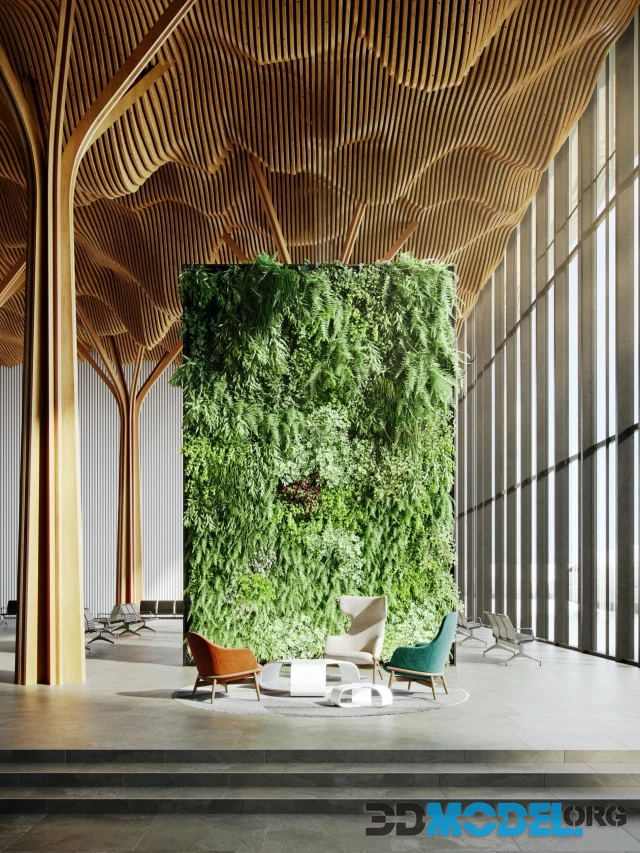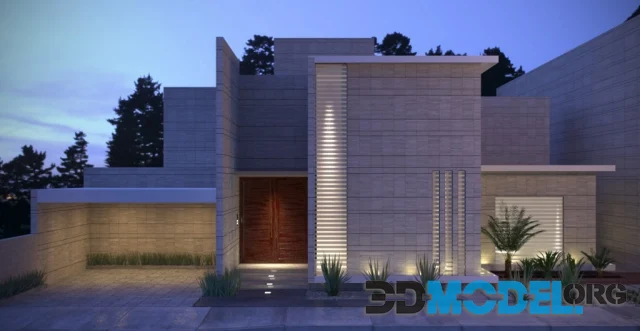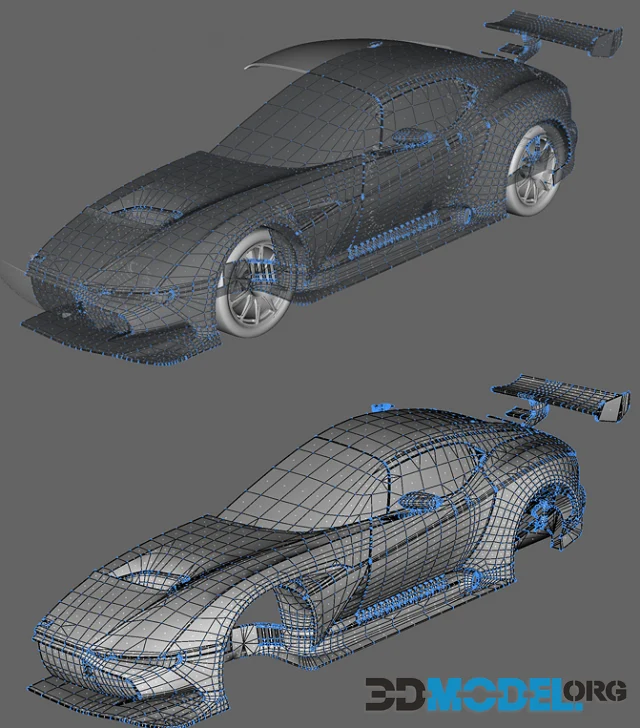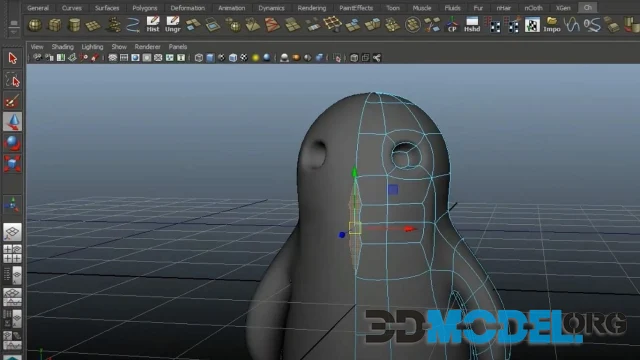Unreal Engine 5 for architectural visualization

Those looking for a software to help them design and create architectural visualizations can look into the Unreal Engine 5.
This program is a powerful, yet easy-to-use tool that can be used by a wide range of people and can be set up for a low to medium hardware requirement. The software is able to provide a range of features, such as Ray tracing, dynamic global illumination, and reflections system.
In our database of 3D-Models you can download free high-quality, ready for architectural rendering 3D meshes of exteriors and interiors.
Ray tracing
Until now, Unreal Engine had not lived up to its potential as an architectural visualization tool. But with the introduction of real time ray tracing in UE4, it's possible to create realistic-looking results in no time.
Ray tracing is the process of simulating the natural behavior of light. It can be used to produce photorealistic CGI and to make photo-realistic renderings. With a little bit of learning, you can enable this feature in your Unreal Engine project.
To render photo-realistic graphics in a fraction of a second, it's important to use a high-quality lighting scheme. Moreover, a clean surface will simplify calculations.
To get started, open up your Unreal Editor and click on Project Settings. Once there, check the "Enable Ray Tracing" option.
Next, increase the "Samples per Pixel" by powers of two. This will ensure that the ray tracing features will take effect.
In addition to increasing the Samples Per Pixel, you can also adjust the "Max Roughness" for the ray traced reflections on materials. This will enable you to create photo-realistic renderings without sacrificing performance.
While ray tracing produces photo-realistic graphics, it can be quite processor-intensive. You'll also need a powerful computer to perform it. In addition, it takes a few frames to calculate the reflections and GI in your scene.
If you want to render your scene in real time, you'll need to install a Nvidia graphics card. The RTX series of cards is ray tracing-friendly. In order to get the most out of your graphics card, you'll need to make sure you have the latest version of Unreal Engine.
To avoid any aliasing, the HDR color weighting tricks in Unreal Engine can help.
Dynamic global illumination and reflections system
Using Unreal Engine 5 for architectural visualization, you can create dynamic global illumination and reflections in real time. This can improve your shadows and create more realistic scenes in real time. The system can also simulate the bounce of light and time of day. This technique is ideal for placing objects, showcasing changes in time of day, and allowing accurate simulation of time of day transitions.
Lumen is the fully dynamic global illumination system in Unreal Engine 5. It reacts to changes in the scene. It uses multiple ray tracing methods to generate global illumination. In addition, it offers a variety of visualization modes to show its version of the scene.
Designed for next generation consoles, Lumen can also be used on high-end PCs. It supports a number of different dynamic lights, including a wide range of specular lights. The primary shipping target for Lumen is large open world games running at 60 frames per second. But it does not support virtual reality systems or split-screen displays.
The Lumen tool has two ray tracing modes. It uses Software Ray Tracing through Signed Distance Fields to create multiple bounce global illumination. It also supports Hardware Ray Tracing for higher quality on video cards supporting RTX.
With Lumen, you can also generate indirect lighting for the surfaces of the object. This can be done by calculating the indirect lighting based on the position of the surface. You can then apply this indirect lighting to your model.
In the future, Unreal Engine 5 will add support for Lumen Reflections in lightmaps. This will enable the global illumination system to work with indirect lighting in lightmaps.
Multi-user editing
Architects and urban planners have been relying on technology to capture reality and create a digital twin of their designs. But it is impossible to fully represent data, due to the limitations of the current technology. With Unreal Engine, designers can now include more data in their architectural visualizations.
Unreal Engine is a tool that allows users to create virtual worlds, share them, and collaborate with colleagues. This software also provides high-quality rendering and animation, and supports multi-user editing.
The multi-user editing feature of Unreal Engine allows multiple people to work on a single project at the same time. This feature can help reduce iteration times and boost team creativity.
Unreal Engine can also be used to create VR/AR experiences, which can allow users to explore cities in a whole new way. The product has been used for a number of immersive experiences, including a cave system generated from real-world photogrammetry assets. The company has even been featured in AEC Magazine for its use in architectural viz.
Several companies have been using the technology, including Zaha Hadid Architects (VR) and AF Infrastructure. Other customers include Ramirent, City Modelling, Buro Happold, Shop Architects (VR), and Allford Hall Monaghan Morris (AHMM).
Unreal Engine 5 is available on PC and Mac, and can be used by both teams, without any licensing restrictions. It offers a powerful stack of visualisation and big data integration tools. It supports the OpenColorIO color-managed pipeline standard, as well as nDisplay technology.
Epic has been investing in the AEC market for several years, and they have made a number of acquisitions, as well as focused on partnerships and in-house development. They have also reduced the costs of the technology, making it free for all users.
Easy-to-use tool with medium hardware requirements
Creating an effective 3D rendered visualization is a complex process requiring a plethora of specialized hardware and software. A well chosen combination of hardware and software will pay dividends in the form of stunning visuals and user interfaces. For the most part, the key to a successful architectural visualization project is to be clear about your goals and stick to your guns.
While the process entails a fair bit of trial and error, the rewards are worth the effort. The resulting product will be a cut above the competition. For a modest investment, you can expect to see the fruits of your labor in the hands of an enthusiastic client within a few months. That is, if you can keep your hands out of your pockets.
While the requisite components and software can be a daunting task, there are still a few viable solutions available. Among these are Unreal Engine and Twinmotion. With a name that translates into a moniker, it's no surprise these two software titans are stealing the thunder from their more entrenched competitors. Having said that, you should also be aware of the shortcomings of both. The former is more of a snob's dream while the latter is a bit more palatable.
A high-end gaming PC paired with a good pair of graphics cards should get the job done in style. A few thousand dollars should be a good place to start. A couple of 10TB hard drives aren't a bad idea. Likewise, a bit of sleuthing will reveal the best deals on motherboards and ram. Having said that, the best places to look aren't always where you would expect.
Quixel library for textures, materials, and 3D models
Founded in 2011, Quixel is a company that specializes in scanning and creating high quality 3D models and textures for architectural visualizations. Its products are used in a wide variety of applications, including film and video games.
Quixel is based in Sweden, where the company has employees spread across six continents. The Megascans library is the world's largest scan database, and contains thousands of photorealistic scans. This resource has been used by major game studios, as well as a number of television and film projects.
As part of the Epic Games family, Quixel is known for its world-class VFX tools and easy-to-use tools. The Quixel Megascans library provides a vast variety of assets for the architectural visualization scene. The Quixel Megascans subscription includes a large amount of assets for a very low price. It also gives users access to the Quixel Bridge software, which includes a variety of creative tools for the Unreal Engine 4.
The materials and textures in the Megascans library are made from real-world locations, and include a variety of objects. It contains rocks, soil, blood, moss, debris, and other items. It is available in several different resolutions and maps.
The Megascans Bridge library allows users to export their scans to a variety of popular renderers. The Quixel Bridge software is available for Windows, Linux, and macOS, and it is compatible with a variety of software packages. It also features powerful scattering, multi-material blending, and advanced physical simulation.
In addition to the Megascans library, Quixel also offers the Mixer application, which is a material authoring tool. It features 50 new Smart Materials, as well as improved ease-of-use. The Mixer is a great resource for architects, designers, and artists who need to create materials.
In our catalog you can download thousands of Assets for Unreal Engine of different versions (4.27, 5.0, 5.1). For your convenience, all the Assets are divided into thematic categories: Animations, Blueprints, Characters, Code Plugins, Visual Effects and others.
Perhaps you will be interested in other articles on this subject:
Ctrl
Enter
Noticed a misTake
Highlight text and press Ctrl+EnterRelated news:
Comments (0)






